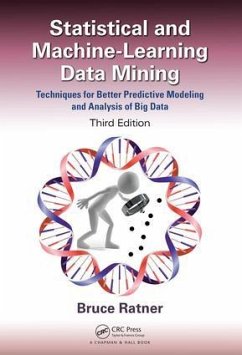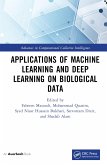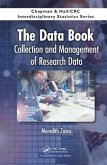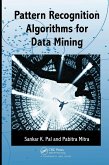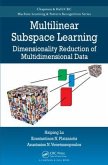Bruce Ratner
Statistical and Machine-Learning Data Mining
Techniques for Better Predictive Modeling and Analysis of Big Data, Third Edition
Bruce Ratner
Statistical and Machine-Learning Data Mining
Techniques for Better Predictive Modeling and Analysis of Big Data, Third Edition
- Gebundenes Buch
- Merkliste
- Auf die Merkliste
- Bewerten Bewerten
- Teilen
- Produkt teilen
- Produkterinnerung
- Produkterinnerung
The third edition of a bestseller, Statistical and Machine-Learning Data Mining: Techniques for Better Predictive Modeling and Analysis of Big Data is still the only book, to date, to distinguish between statistical data mining and machine-learning data mining.
Andere Kunden interessierten sich auch für
![Applications of Machine Learning and Deep Learning on Biological Data Applications of Machine Learning and Deep Learning on Biological Data]() Applications of Machine Learning and Deep Learning on Biological Data144,99 €
Applications of Machine Learning and Deep Learning on Biological Data144,99 €![Physics of Data Science and Machine Learning Physics of Data Science and Machine Learning]() Ijaz A RaufPhysics of Data Science and Machine Learning116,99 €
Ijaz A RaufPhysics of Data Science and Machine Learning116,99 €![The Data Book The Data Book]() Meredith ZozusThe Data Book96,99 €
Meredith ZozusThe Data Book96,99 €![Applied Data Mining Applied Data Mining]() Guandong XuApplied Data Mining135,99 €
Guandong XuApplied Data Mining135,99 €![Pattern Recognition Algorithms for Data Mining Pattern Recognition Algorithms for Data Mining]() Sankar K PalPattern Recognition Algorithms for Data Mining164,99 €
Sankar K PalPattern Recognition Algorithms for Data Mining164,99 €![Multilinear Subspace Learning Multilinear Subspace Learning]() Haiping LuMultilinear Subspace Learning135,99 €
Haiping LuMultilinear Subspace Learning135,99 €![Machine Learning and IoT for Intelligent Systems and Smart Applications Machine Learning and IoT for Intelligent Systems and Smart Applications]() Machine Learning and IoT for Intelligent Systems and Smart Applications144,99 €
Machine Learning and IoT for Intelligent Systems and Smart Applications144,99 €-
-
-
The third edition of a bestseller, Statistical and Machine-Learning Data Mining: Techniques for Better Predictive Modeling and Analysis of Big Data is still the only book, to date, to distinguish between statistical data mining and machine-learning data mining.
Produktdetails
- Produktdetails
- Verlag: Taylor & Francis Ltd (Sales)
- 3rd edition
- Seitenzahl: 690
- Erscheinungstermin: 1. Juni 2017
- Englisch
- Abmessung: 257mm x 180mm x 43mm
- Gewicht: 1297g
- ISBN-13: 9781498797603
- ISBN-10: 1498797601
- Artikelnr.: 48454341
- Herstellerkennzeichnung
- Libri GmbH
- Europaallee 1
- 36244 Bad Hersfeld
- gpsr@libri.de
- Verlag: Taylor & Francis Ltd (Sales)
- 3rd edition
- Seitenzahl: 690
- Erscheinungstermin: 1. Juni 2017
- Englisch
- Abmessung: 257mm x 180mm x 43mm
- Gewicht: 1297g
- ISBN-13: 9781498797603
- ISBN-10: 1498797601
- Artikelnr.: 48454341
- Herstellerkennzeichnung
- Libri GmbH
- Europaallee 1
- 36244 Bad Hersfeld
- gpsr@libri.de
Bruce Ratner, The Significant StatisticianTM, is President and Founder of DM STAT-1 Consulting, the ensample for Statistical Modeling, Analysis and Data Mining, and Machine-learning Data Mining in the DM Space. DM STAT-1 specializes in all standard statistical techniques, and methods using machine-learning/statistics algorithms, such as its patented GenIQ Model, to achieve its clients' goals - across industries including Direct and Database Marketing, Banking, Insurance, Finance, Retail, Telecommunications, Healthcare, Pharmaceutical, Publication & Circulation, Mass & Direct Advertising, Catalog Marketing, e-Commerce, Web-mining, B2B, Human Capital Management, Risk Management, and Nonprofit Fundraising. Bruce holds a doctorate in mathematics and statistics, with a concentration in multivariate statistics and response model simulation. His research interests include developing hybrid-modeling techniques, which combine traditional statistics and machine learning methods. He holds a patent for a unique application in solving the two-group classification problem with genetic programming.
Preface to Third Edition
Preface of Second Edition
Acknowledgments
Author
1. Introduction
2. Science Dealing with Data: Statistics and Data Science
3. Two Basic Data Mining Methods for Variable Assessment
4. CHAID-Based Data Mining for Paired-Variable Assessment
5. The Importance of Straight Data Simplicity and Desirability for Good
Model-Building Practice
6. Symmetrizing Ranked Data: A Statistical Data Mining Method for Improving
the Predictive Power of Data
7. Principal Component Analysis: A Statistical Data Mining Method for
Many-Variable Assessment
8. Market Share Estimation: Data Mining for an Exceptional Case
9. The Correlation Coefficient: Its Values Range between Plus and Minus 1,
or Do They?
10. Logistic Regression: The Workhorse of Response Modeling
11. Predicting Share of Wallet without Survey Data
12. Ordinary Regression: The Workhorse of Profit Modeling
13. Variable Selection Methods in Regression: Ignorable Problem, Notable
Solution
14. CHAID for Interpreting a Logistic Regression Model
15. The Importance of the Regression Coefficient
16. The Average Correlation: A Statistical Data Mining Measure for
Assessment of Competing Predictive Models and the Importance of the
Predictor Variables
17. CHAID for Specifying a Model with Interaction Variables
18. Market Segmentation Classification Modeling with Logistic Regression
19. Market Segmentation Based on Time-Series Data Using Latent Class
Analysis
20. Market Segmentation: An Easy Way to Understand the Segments
21. The Statistical Regression Model: An Easy Way to Understand the Model
22. CHAID as a Method for Filling in Missing Values
23. Model Building with Big Complete and Incomplete Data
24. Art, Science, Numbers, and Poetry
25. Identifying Your Best Customers: Descriptive, Predictive, and
Look-Alike Profiling
26. Assessment of Marketing Models
27. Decile Analysis: Perspective and Performance
28. Net T-C Lift Model: Assessing the Net Effects of Test and Control
Campaigns
29. Bootstrapping in Marketing: A New Approach for Validating Models
30. Validating the Logistic Regression Model: Try Bootstrapping
31. Visualization of Marketing Models: Data Mining to Uncover Innards of a
Model
32. The Predictive Contribution Coefficient: A Measure of Predictive
Importance
33. Regression Modeling Involves Art, Science, and Poetry, Too
34. Opening the Dataset: A Twelve-Step Program for Dataholics
35. Genetic and Statistic Regression Models: A Comparison
36. Data Reuse: A Powerful Data Mining Effect of the GenIQ Model
37. A Data Mining Method for Moderating Outliers Instead of Discarding Them
38. Overfitting: Old Problem, New Solution
39. The Importance of Straight Data: Revisited
40. The GenIQ Model: Its Definition and an Application
41. Finding the Best Variables for Marketing Models
42. Interpretation of Coefficient-Free Models
43. Text Mining: Primer, Illustration, and TXTDM Software
44. Some of My Favorite Statistical Subroutines
Index
Preface of Second Edition
Acknowledgments
Author
1. Introduction
2. Science Dealing with Data: Statistics and Data Science
3. Two Basic Data Mining Methods for Variable Assessment
4. CHAID-Based Data Mining for Paired-Variable Assessment
5. The Importance of Straight Data Simplicity and Desirability for Good
Model-Building Practice
6. Symmetrizing Ranked Data: A Statistical Data Mining Method for Improving
the Predictive Power of Data
7. Principal Component Analysis: A Statistical Data Mining Method for
Many-Variable Assessment
8. Market Share Estimation: Data Mining for an Exceptional Case
9. The Correlation Coefficient: Its Values Range between Plus and Minus 1,
or Do They?
10. Logistic Regression: The Workhorse of Response Modeling
11. Predicting Share of Wallet without Survey Data
12. Ordinary Regression: The Workhorse of Profit Modeling
13. Variable Selection Methods in Regression: Ignorable Problem, Notable
Solution
14. CHAID for Interpreting a Logistic Regression Model
15. The Importance of the Regression Coefficient
16. The Average Correlation: A Statistical Data Mining Measure for
Assessment of Competing Predictive Models and the Importance of the
Predictor Variables
17. CHAID for Specifying a Model with Interaction Variables
18. Market Segmentation Classification Modeling with Logistic Regression
19. Market Segmentation Based on Time-Series Data Using Latent Class
Analysis
20. Market Segmentation: An Easy Way to Understand the Segments
21. The Statistical Regression Model: An Easy Way to Understand the Model
22. CHAID as a Method for Filling in Missing Values
23. Model Building with Big Complete and Incomplete Data
24. Art, Science, Numbers, and Poetry
25. Identifying Your Best Customers: Descriptive, Predictive, and
Look-Alike Profiling
26. Assessment of Marketing Models
27. Decile Analysis: Perspective and Performance
28. Net T-C Lift Model: Assessing the Net Effects of Test and Control
Campaigns
29. Bootstrapping in Marketing: A New Approach for Validating Models
30. Validating the Logistic Regression Model: Try Bootstrapping
31. Visualization of Marketing Models: Data Mining to Uncover Innards of a
Model
32. The Predictive Contribution Coefficient: A Measure of Predictive
Importance
33. Regression Modeling Involves Art, Science, and Poetry, Too
34. Opening the Dataset: A Twelve-Step Program for Dataholics
35. Genetic and Statistic Regression Models: A Comparison
36. Data Reuse: A Powerful Data Mining Effect of the GenIQ Model
37. A Data Mining Method for Moderating Outliers Instead of Discarding Them
38. Overfitting: Old Problem, New Solution
39. The Importance of Straight Data: Revisited
40. The GenIQ Model: Its Definition and an Application
41. Finding the Best Variables for Marketing Models
42. Interpretation of Coefficient-Free Models
43. Text Mining: Primer, Illustration, and TXTDM Software
44. Some of My Favorite Statistical Subroutines
Index
Preface to Third Edition
Preface of Second Edition
Acknowledgments
Author
1. Introduction
2. Science Dealing with Data: Statistics and Data Science
3. Two Basic Data Mining Methods for Variable Assessment
4. CHAID-Based Data Mining for Paired-Variable Assessment
5. The Importance of Straight Data Simplicity and Desirability for Good
Model-Building Practice
6. Symmetrizing Ranked Data: A Statistical Data Mining Method for Improving
the Predictive Power of Data
7. Principal Component Analysis: A Statistical Data Mining Method for
Many-Variable Assessment
8. Market Share Estimation: Data Mining for an Exceptional Case
9. The Correlation Coefficient: Its Values Range between Plus and Minus 1,
or Do They?
10. Logistic Regression: The Workhorse of Response Modeling
11. Predicting Share of Wallet without Survey Data
12. Ordinary Regression: The Workhorse of Profit Modeling
13. Variable Selection Methods in Regression: Ignorable Problem, Notable
Solution
14. CHAID for Interpreting a Logistic Regression Model
15. The Importance of the Regression Coefficient
16. The Average Correlation: A Statistical Data Mining Measure for
Assessment of Competing Predictive Models and the Importance of the
Predictor Variables
17. CHAID for Specifying a Model with Interaction Variables
18. Market Segmentation Classification Modeling with Logistic Regression
19. Market Segmentation Based on Time-Series Data Using Latent Class
Analysis
20. Market Segmentation: An Easy Way to Understand the Segments
21. The Statistical Regression Model: An Easy Way to Understand the Model
22. CHAID as a Method for Filling in Missing Values
23. Model Building with Big Complete and Incomplete Data
24. Art, Science, Numbers, and Poetry
25. Identifying Your Best Customers: Descriptive, Predictive, and
Look-Alike Profiling
26. Assessment of Marketing Models
27. Decile Analysis: Perspective and Performance
28. Net T-C Lift Model: Assessing the Net Effects of Test and Control
Campaigns
29. Bootstrapping in Marketing: A New Approach for Validating Models
30. Validating the Logistic Regression Model: Try Bootstrapping
31. Visualization of Marketing Models: Data Mining to Uncover Innards of a
Model
32. The Predictive Contribution Coefficient: A Measure of Predictive
Importance
33. Regression Modeling Involves Art, Science, and Poetry, Too
34. Opening the Dataset: A Twelve-Step Program for Dataholics
35. Genetic and Statistic Regression Models: A Comparison
36. Data Reuse: A Powerful Data Mining Effect of the GenIQ Model
37. A Data Mining Method for Moderating Outliers Instead of Discarding Them
38. Overfitting: Old Problem, New Solution
39. The Importance of Straight Data: Revisited
40. The GenIQ Model: Its Definition and an Application
41. Finding the Best Variables for Marketing Models
42. Interpretation of Coefficient-Free Models
43. Text Mining: Primer, Illustration, and TXTDM Software
44. Some of My Favorite Statistical Subroutines
Index
Preface of Second Edition
Acknowledgments
Author
1. Introduction
2. Science Dealing with Data: Statistics and Data Science
3. Two Basic Data Mining Methods for Variable Assessment
4. CHAID-Based Data Mining for Paired-Variable Assessment
5. The Importance of Straight Data Simplicity and Desirability for Good
Model-Building Practice
6. Symmetrizing Ranked Data: A Statistical Data Mining Method for Improving
the Predictive Power of Data
7. Principal Component Analysis: A Statistical Data Mining Method for
Many-Variable Assessment
8. Market Share Estimation: Data Mining for an Exceptional Case
9. The Correlation Coefficient: Its Values Range between Plus and Minus 1,
or Do They?
10. Logistic Regression: The Workhorse of Response Modeling
11. Predicting Share of Wallet without Survey Data
12. Ordinary Regression: The Workhorse of Profit Modeling
13. Variable Selection Methods in Regression: Ignorable Problem, Notable
Solution
14. CHAID for Interpreting a Logistic Regression Model
15. The Importance of the Regression Coefficient
16. The Average Correlation: A Statistical Data Mining Measure for
Assessment of Competing Predictive Models and the Importance of the
Predictor Variables
17. CHAID for Specifying a Model with Interaction Variables
18. Market Segmentation Classification Modeling with Logistic Regression
19. Market Segmentation Based on Time-Series Data Using Latent Class
Analysis
20. Market Segmentation: An Easy Way to Understand the Segments
21. The Statistical Regression Model: An Easy Way to Understand the Model
22. CHAID as a Method for Filling in Missing Values
23. Model Building with Big Complete and Incomplete Data
24. Art, Science, Numbers, and Poetry
25. Identifying Your Best Customers: Descriptive, Predictive, and
Look-Alike Profiling
26. Assessment of Marketing Models
27. Decile Analysis: Perspective and Performance
28. Net T-C Lift Model: Assessing the Net Effects of Test and Control
Campaigns
29. Bootstrapping in Marketing: A New Approach for Validating Models
30. Validating the Logistic Regression Model: Try Bootstrapping
31. Visualization of Marketing Models: Data Mining to Uncover Innards of a
Model
32. The Predictive Contribution Coefficient: A Measure of Predictive
Importance
33. Regression Modeling Involves Art, Science, and Poetry, Too
34. Opening the Dataset: A Twelve-Step Program for Dataholics
35. Genetic and Statistic Regression Models: A Comparison
36. Data Reuse: A Powerful Data Mining Effect of the GenIQ Model
37. A Data Mining Method for Moderating Outliers Instead of Discarding Them
38. Overfitting: Old Problem, New Solution
39. The Importance of Straight Data: Revisited
40. The GenIQ Model: Its Definition and an Application
41. Finding the Best Variables for Marketing Models
42. Interpretation of Coefficient-Free Models
43. Text Mining: Primer, Illustration, and TXTDM Software
44. Some of My Favorite Statistical Subroutines
Index

